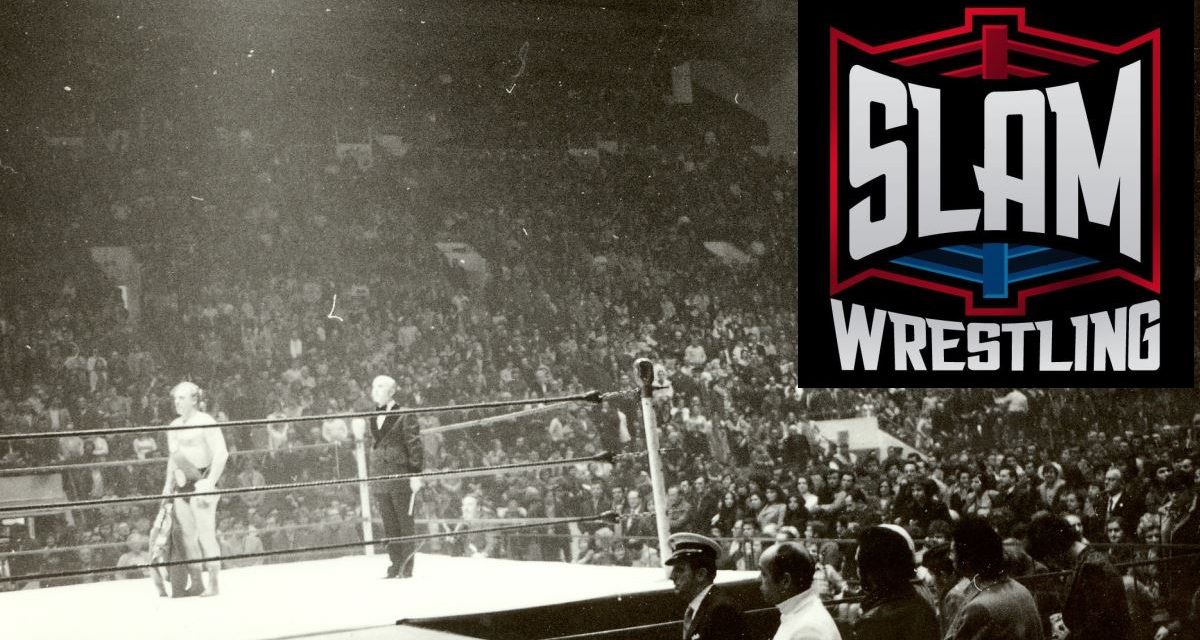As an employee during one of its most memorable eras, Kim Michael Porter joined the WWF in 1988 as part of the ring crew, helping to set up and tear down the ring at house shows and tours across the United States and Western Canada. As fate would have it, a fill-in ring announcer was needed, providing an opportunity that would change the course of Porter’s career and allow access to work with many of the WWF’s most distinguished personalities including Andre the Giant, Howard Finkel, Mean Gene Okerlund, Jake “The Snake” Roberts and “Earthquake” John Tenta.
It all started with a letter from Gridley, California, at the age of 32.
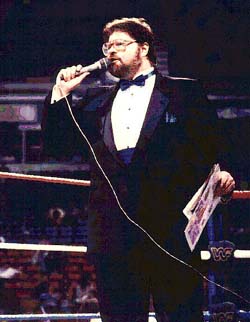
Announcer Michael Porter. All photos courtesy Michael Porter
“Back in the late ’60s and early ’70s I was working for Northern California promoters Roy Shire and Louie Miller as a security man,” recalled Porter to SLAM! Wrestling. “I started selling programs, and finally I got a shot at ring announcing. From there in the ’70s, I worked as a ring announcer for a promoter in Northern California, Terry Garvin (Terry Joyal), who booked for Shire on the NorCal circuit. Then in 1988, while I lived in Gridley, the WWF advertised a show in Chico, which was only 30 miles from Gridley. I was shocked that they would be so close, so I went. I asked the road agent if they needed a ring announcer. He told me that they already had one for the night, but asked me what experience I had. I told him about working for Shire, Miller and Garvin. He then told me that Terry Garvin was now the number three man in the WWF and asked me if I wanted his contact info. I was again shocked and said “Yes.” I then contacted — by snail-mail — Terry Garvin.
“Three months later, I was working for the WWF.”
Like many new hires, Porter had to earn his stripes in the beginning. “My first event on December 17th at the Sports Arena in Los Angeles. The head agent at the time was Chief Jay Strongbow. My crew chief was Mike Twomey. We had to get to the Sports Arena about 10:00 a.m. to begin the ring set-up,” he explained. “It was difficult for me, carrying all of the heavy parts of the ring to ringside for the set-up. We couldn’t drive right up to ringside, like so many other arenas, so it made it more difficult.”
How long did it usually take setting up the grand stage?
“Well, it would vary, depending upon the venue. At most buildings, we could drive right up to ringside. In those cases we could unload and immediately begin the set-up, which would take anywhere from two to three hours. At the arenas where we couldn’t do the drive-up, we would have to hand-carry each part of the ring or place them onto large or small push carts and take them to the ring. In those cases, it could take much longer because we had to perform the setup properly; the wrestlers’ ultimate safety was in our hands.”

Once the groundwork was completed, Porter performed some of the more visible duties, including gathering the costumes from ringside. “Since I was a rookie, I wasn’t told anything about the shows. I was just told to get the ring entrance gimmicks and take them to the back. That was my ‘job’ for the night, until it was time to tear the ring down at the end of the show,” said Porter with a laugh. “Since I was new, I was basically kayfabed, at least until everyone got to know me.”
Some of the events were recorded and put on television shows such as WWF Prime Time Wrestling. Gradually he started earning the trust of the talent, who initiated him into the family circle the night on his first tour. “It was in Fargo, North Dakota, I believe. I was told where to change into my show clothes,” Porter recounted. “So, I went there, and started changing. While I was down to my underwear, I was told ‘Not here.’ It was the boys dressing room. I was embarrassed. I thought I had done something wrong and was going to get in trouble with the Chief. So I picked up my belongings and got the heck out of there, clad in just my underwear. Before I got to another dressing room, I was spotted by Sherri Martel and I believe, Rockin’ Robin! They whistled, I blushed and I ran. It turned out to be a ‘rib’ on me. But was I embarrassed,” lamented Porter.
The tours were especially grinding; 24-hour days were sometimes required, depending on how many shows the tour packed into consecutive days. Drives of 400 miles to the next town were not uncommon after finishing up a show. Porter ended up across much of the United States and Western Canada, doing shows in Vancouver, Victoria, and Calgary where he met Canadian legend Billy Red Lyons. It was obvious that the WWF was doing brisk business. “I heard at one time that they had 12 or 13 regional ring crews working,” said Porter.
His announcing break came in 1989 after approximately a year on the job. “The ring crew chief, Mike Twomey, who was scheduled to announce that night, had to fly out early, get another truck and ring and head out to another tour. This was the last night of my tour,” Porter explained. “So the head agent that night, Grizzly Smith (Jake Roberts’ father) had been told by Terry Garvin to have me announce, because I had announced for Terry years earlier on the Northern California circuit.
“I had no time to prepare, so I just decided to wing it by taking a style similar to Howard Finkel. I was told that I did a fine job, and got announcers pay and a bonus. I was on Dream Street,” he laughed.
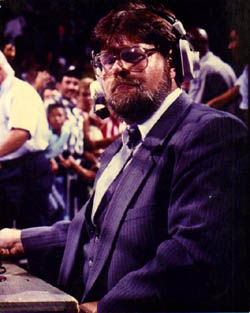
Michael Porter at ringside.
From that day forward, announcing was added to his duties. While the WWF did go on overseas tours, Porter noted the special events like WrestleMania and the international tours usually went to the tenured crew staff.
“I always have good things to say about Michael Porter. He was the all-American boy, who was well liked by everyone,” said former WWF superstar Koko B. Ware. “He would announce, tear down the ring, referee, and basically work his butt off for you. I remember in Sacramento, he was announcing, and I was doing the Birdman dance in the ring with everyone. I took off Mike’s glasses and put mine on him. When I put his glasses on, I could barely see straight. Man, those were some powerful glasses.”
So, what did the ring announcing consist of?
“Well, before the WWF, I would have to get hometowns and weights, but with WWF, that was already provided,” said Porter. “I would use the same sheet that was in that night’s WWF program, unless there was a change in the card. My prep time was just working myself up to get out there with enthusiasm, and to get the crowd pumped for the show with my opening announcements. Then, raise the level as the first match would begin, just after the national anthem. It was very important to get the crowd pumped into a frenzy before the opening match.”
It also provided another dimension of involvement with the wrestlers. Porter became familiar with their routines and idiosyncrasies, which would sometimes lead to an unscripted interaction before the match. One notable wrestler who Porter says was hard to predict was the late “Bad News” Brown (Allen Coage), who liked to surprise the tuxedos in the ring.
Financially, things were improving as well. “I was considered ‘Talent’ (after announcing), and it was shortly thereafter that I was put on payroll and signed my WWF contract. This meant I would be paid whether I worked or not, and back in 1989, $1,200 a month base pay was big money to a small-town country boy like me,” said Porter. “There were some months that I would only work three or four shows but would still get my base pay. And when I would work, I would get extra for whichever job I did that night.”
Becoming a more active participant in the shows, often meant working with the top talent that night, and Porter made sure to enjoy every minute of it. He recalled working with a young Shane McMahon on several house shows. “Vince wanted Shane to learn the business from the ground up,” explained Porter. “Shane worked as a referee for the four shows I worked with him.”
On the house show and tour circuits, regions would often have a pre-determined announcer. Veteran grappler Bill Anderson was the go-to guy in Southern California. In those cases, Porter would work alongside them as the timekeeper, cue up the theme music, or other behind-the-scenes tasks.
TV announcing remained the unquestioned domain of the big three: Howard Finkel, Mel Phillips, and Mike McGuirk. Porter recalled them as being great people and very helpful, also noting Finkel is an “encyclopedia of wrestling.”
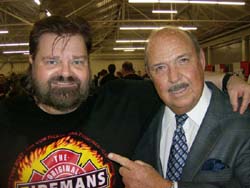
Michael Porter and Gene Okerlund at WrestleFanFest in October 2007.
They also weren’t above an occasional prank or two, much like Bobby “The Brain” Heenan, “Mean Gene” Okerlund and Gorilla Monsoon proved. “It was in Wheeling, West Virginia… on the night that ‘Earthquake’ John Tenta made his debut with the pushup contest between Dino Bravo and The Ultimate Warrior,” he said. “I was walking by, when Bobby, Gorilla, and Gene informed me that Vince wanted me to announce the main event that night — Hulk Hogan against Randy Savage. I said ‘What? I’m not announcing. This is TV.’ Gene said, ‘Well, you tell Vince that you’re not announcing.’
“I looked at them for some sign of a smile,” continued Porter. “But they just had serious and concerned looks on their faces. I was real shook up at that time, so I grabbed my garment bag, ran onto the tour bus, and started changing into my tuxedo. I was sweating like mad and then came off the bus and there they were, just laughing like crazy. I’d been had.
“I heard later that this rib had been set up by Owen Hart. I never did find out for certain if it was him or someone else. But actually, I hope that it was Owen. He was such a wonderful person.”
Then there was the face to face with Vince McMahon, backstage, also in Wheeling. Porter accidentally bumped into him and though Porter was no small man at 5-foot-11 and 275 pounds, he was the one who was knocked to the ground. “I apologized, and mentioned to him that I had been wanting to meet him, but I just wasn’t sure how to approach him,” recaleld Porter. “He told me that I just should’ve come to him. I introduced myself to him, by name, and he said ‘Yes, I know who you are! I’ve heard good reports about you.’
“I was shocked to say the least.”
After exchanging some pleasantries, each was on their way, none the worse for wear.
Porter was making an impression, perhaps too much of one.
“While I was with WWF, I was diagnosed with obstructive sleep apnea, the sleep disorder. But before that, Mike Twomey, my ring crew chief had received two DUIs in less than three months, and his driver’s license was taken away. So, since he couldn’t drive, I had to do all of the driving, and in turn, I was made ring crew chief over him.
“That pissed him off. Now he had no problem with falling asleep, whenever I was driving. I couldn’t even get him to stay awake to keep me company on long drives. But he never forgave me for being his boss,” Porter explained. “And when he finally got his license back, he expected to be made Chief again, but he wasn’t. The office was more than pleased with me and kept me as Chief. So, he went over our boss’s head, went to the Department of Transportation, a federal office, and told them of my apnea, saying that he was afraid that I would fall asleep at the wheel and kill us both, which was a bold-faced lie because like I said, he had no problem falling asleep.
“My commercial driving license was immediately suspended so I could not drive the WWF trucks. I was delegated to only announcing. I didn’t mind this, but because I couldn’t drive, I was taken off payroll and would drive my own car to events only in California, or they would fly me to certain events to announce.”
Was Twomey reinstated as Chief?
“No,” chuckled Porter. “He was fired before I was released. The front office and the talent made it known that they didn’t want to work with him after what he did to me.”
But alas, in 1993 the sun was beginning to set on the WWF’s golden run. Trips to the west coast were becoming less frequent and Porter was released, his last show being June 26, 1993 at the Arco Arena in Sacramento.
Porter still cherishes the bonds he was able to forge with many of the talent, most notably the late Earthquake and Sherri Martel.
Martel was known for her kindness, and she surprised Porter with it once again a few years down the road. “I was doing a radio show on a local AM radio station (AM-1410 KMYC) out here in Marysville, California. It was called Michael Porter’s WrestleShoot,” explained Porter. “Sherri called in to my show one time, but she was scheduled to call in two weeks before. She had fallen asleep on the couch waiting to call. My show was on a Sunday night at 8:00 p.m., so that was about 10 or 11 p.m. her time. She knew my ex-wife, Tracy, from when I introduced them before. Tracy’s daughter, Megan, had a son named Andrew, who was born blind. And to apologize for not calling before, Sherri sent to me to sell, in hopes to raise money for Andrew to get much needed treatment for his blindness, two dresses that she wore in the WWF and a bunch of autographed pictures to sell also. Tracy was in the studio for the night of Sherri’s call to the show, because she wanted to talk to Sherri too. It was then that Sherri told us what she wanted to do. We were all in tears at this news,” said Porter.
Porter was directly involved in the “Death of Damien” angle where Earthquake stomped Jake Roberts’ sidekick to a pulp in the ring. Asked before the show by McMahon to stuff some nylons with hamburger to simulate the python, the segment prompted a visit from the Animal Authorities Control in Reno the next night to investigate complaints about the on-air incident. Once they were satisfied the snake was alive and unharmed, the show continued.
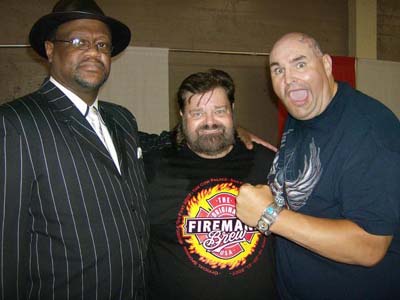
Slick, Michael Porter and One Man Gang at WrestleFanFest in October 2007.
Today at age 56, Porter remains involved in wrestling, currently announcing with the Devil Mountain Wrestling promotion in San Francisco. He is considering reprising his popular Wrestlebeat column and WrestleShoot radio program and recently caught up with long time friends at a recent WrestleFanFest event at the Cow Palace in San Francisco in October. He looks back fondly at his time in the Federation, whether it was tearing down the ring with the crew, or enjoying a meal with Tenta, Kerry Von Erich and The Undertaker after a show, he took advantage of an opportunity that few in the business are presented with.
“I loved working for the WWF. It was a family-like atmosphere. They treated me like one of the boys. The talent would show me pictures of their loved ones, confide personal moments and memories to me, which I have never told anyone. They trusted me. I was always welcomed to any WWF show after I left, backstage and all.”
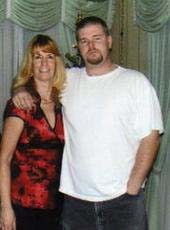
Michael Porter’s son, Luke Lawrence Lind, and his adopted mother, Nancy, in 2006.
Porter has been focusing on an important personal objective: regaining contact with his son, Luke Lawrence Lind. It’s a thought that puts his experience in the wrestling business into perspective.
“I’ve been trying to find him for years. I haven’t seen Luke since he was just about and five and a half years old,” said Porter with a serious tone. “Luke’s mother, Linda and I were separated when he was born, and I was told that he was born dead. I later found out that he was alive, but Linda had put him up for adoption. I fought it for years and went totally broke, and couldn’t afford to pay my lawyers any more money, so they dropped the case. It’s now over 24 years since I’ve seen him.
“I do know that his adoptive mother and father are divorced, and the adoptive mother has re-married and is living somewhere in Oregon. I have had cancer on two occasions, and have survived both times. I want to see my son before I die. So emotionally, I guess you could say that if I never get to see him again, I will have lived my whole life in vain,” he said somberly.
“I’m keeping the faith that I’ll get to see him again.”
RELATED LINK
- October 15, 2010: Former WWE ring announcer Michael Porter dies
